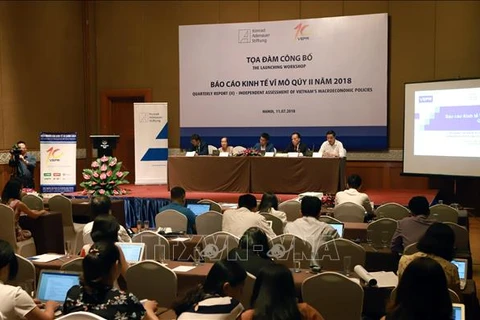Hanoi (VNA) – The latest ‘tiger’ economy in Asia is Vietnam as the country emerges as one of the world’s fastest growing economies, said the Qatar National Bank (QNB) in its weekly ‘economic commentary’ published on thepeninsulaqatar.com.
A range of indicators recorded in the first six months of 2018 demonstrated the booming Vietnamese economy. Its gross domestic product (GDP) grew 7.1 percent year on year, the fastest since 2011. The output of Vietnam’s manufacturing sector increased 13.1 percent on year.
According to QNB analysts, the manufacturing boom fueled exports to annually surge 20 percent in the period compared to the 17 percent increase posted for the entire 2017.
The bank attributed manufacturing and export success to Vietnam’s ability to attract a large volume of foreign direct investment (FDI) into sectors like garment, footwear and electronics. FDI inflows in the Southeast Asian country also boomed, with total value estimated at 13 billion USD in the first half of this year, an annual increase of 11 percent.
The GDP figure for 2017 was about 220 billion USD, according to the latest data from the International Monetary Fund (IMF).
The QNB said Vietnam’s economic success is noteworthy as it comes at a time when many developing economies are struggling to match the success of Asia’s previous ‘tigers’ like Singapore and the Republic of Korea. It said the basis for such achievement is obvious, namely favourable demographics, low wage rates, political stability, and geographical location.
The commentary cited recent research from the Brookings Institute think tank in the US which highlighted that the ability to build on these solid foundations via good policies is what really sets Vietnam apart.
There are three critical factors behind the country’s high growth. First, Vietnam has eagerly pursued trade liberalisation on both multilateral and bilateral basis. Trade agreements have dramatically lowered the external tariffs its exports face, helping integrate Vietnam into the global economy and further accelerating FDI investments.
Second, Vietnam’s investments in human capital i.e. education have helped the country maximise its demographic potential. Vietnam was ranked 8th out of 72 participating countries in the latest Programme for International Student Assessment (PISA), which tests high school students in maths, science, and other subjects. The result surpassed several top economies of the Organisation for Economic Cooperation and Development (OECD), which conducts the PISA.
Third, investments in human capital have been supported by progress in improving the local business climate. Vietnam has steadily moved up in both the World Economic Forum’s competitiveness index and the World Bank’s ease of doing business survey.
The QNB noted the success might come along with vulnerabilities and challenges. FDI in Vietnam mostly concentrates in the textiles and electronics sectors, creating jobs, which tend to be of low skills and low wage with little value added. This leaves Vietnam exposed to the crossfire of a US-China trade war in the short term. In longer term, Vietnam’s competitive advantages might fade, as the country climbs the development ladder, and wage rates and living standards improve.
The bank also pointed to new economic drivers that could help Vietnam sustain its current position in a few years. Vietnam’s high PISA scores suggested that the country should be able to move up the global value chain more easily than most emerging markets.
Prospects for rapid growth in the service sector, particularly tourism, could help drive economic growth over the longer term. In the latest data, tourist arrivals in the country was up nearly 25 percent in June from 2017.-VNA

Vietnam’s economy maintains growth momentum over year’s second quarter
The Vietnamese economy continued to enjoy growth in the second quarter of 2018, following an impressive growth impetus in the first three months of this year, according to the Department of Planning under the Ministry of Industry and Trade.
























